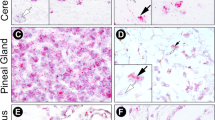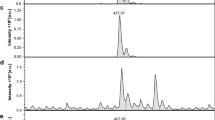Abstract
PHENOTHIAZINES and related neuroleptic drugs, such as thioxanthenes, markedly increase the content of homovanillic acid (3-methoxy-4-hydroxyphenylacetic acid) in the brain, especially in the extrapyramidal centres of various animal species. This has raised the question of whether neuroleptic drugs accelerate the synthesis of catecholamines through a feed-back mechanism either as a result of blockade of dopaminergic and noradrenergic receptors or of alteration of the amine storage1–6,16. The present communication shows that in vivo chlorpromazine and related neuroleptics markedly enhance the hydroxylation of tyrosine which seems to be a rate-limiting step in the formation of catecholamines7.
This is a preview of subscription content, access via your institution
Access options
Subscribe to this journal
Receive 51 print issues and online access
$199.00 per year
only $3.90 per issue
Buy this article
- Purchase on Springer Link
- Instant access to full article PDF
Prices may be subject to local taxes which are calculated during checkout
Similar content being viewed by others
References
Gey, K. F., and Pletscher, A., J. Pharmacol. Exp. Ther., 145, 337 (1964).
Andén, N. E., Roos, B. E., and Werdinius, B., Life Sci., 3, 149 (1964).
Laverty, R., and Sharman, D. F., Brit. J. Pharmacol., 24, 759 (1965).
Da Prada, M., and Pletscher, A., Experientia, 22, 465 (1966).
Jurio, A. V., Sharman, D. F., and Trajkov, T., Brit. J. Pharmacol., 26, 385 (1966).
Carlsson, C., Denker, S. J., Grimby, G., and Haggendal, J., Scand. J. Clin. Lab. Invest., 17, suppl. 86, 134 (1965).
Levitt, M., Spector, S., Sjoerdsma, A., and Udenfriend, S., J. Pharmacol. Exp. Ther., 148, 1 (1965).
Nagatsu, T., Levitt, M., and Udenfriend, S., J. Biol. Chem., 239, 2910 (1964).
Waalkes, T. P., and Udenfriend, S., J. Lab. Clin. Med., 50, 733 (1957).
Ferri, S., Boll. Ital. Biol. Sper., 40, 1693 (1964).
Gordon, M. W., Fed. Proc., 24, 301 (1965).
Yuwiler, A., Geller, E., Schapiro, S., and Seater, G. G., Biochem. Pharmacol., 14, 621 (1965).
Shuster, L., and Hannam, R. V., J. Biol. Chem., 239, 3401 (1964).
Satanove, A., J. Amer. Med. Assoc., 191, 263 (1965).
Greiner, A. C., and Nicolson, G. A., Canad. Med. Assoc. J., 91, 627 (1964).
Bernheimer, H., and Hornykiewicz, O., Arch. Exp. Path. Pharmak., 251, 135 (1965).
Author information
Authors and Affiliations
Rights and permissions
About this article
Cite this article
BURKARD, W., GEY, K. & PLETSCHER, A. Activation of Tyrosine Hydroxylation in Rat Brain in vivo by Chlorpromazine. Nature 213, 732–733 (1967). https://doi.org/10.1038/213732a0
Issue Date:
DOI: https://doi.org/10.1038/213732a0
This article is cited by
-
An experimental model of tardive dyskinesia
Journal of Neural Transmission (1972)
-
Observations on the dopaminergic nature of hyperthyroid chorea
Journal of Neural Transmission (1972)
-
Effect of an extract of cannabis and of some cannabinols on catecholamine metabolism in rat brain and heart
Agents and Actions (1970)
-
Acceleration of turnover of14C-catecholamines in rat brain by chlorpromazine
Experientia (1968)
-
Decrease of norepinephrine in brain and heart of vitamin E deficient rats
Experientia (1968)
Comments
By submitting a comment you agree to abide by our Terms and Community Guidelines. If you find something abusive or that does not comply with our terms or guidelines please flag it as inappropriate.



